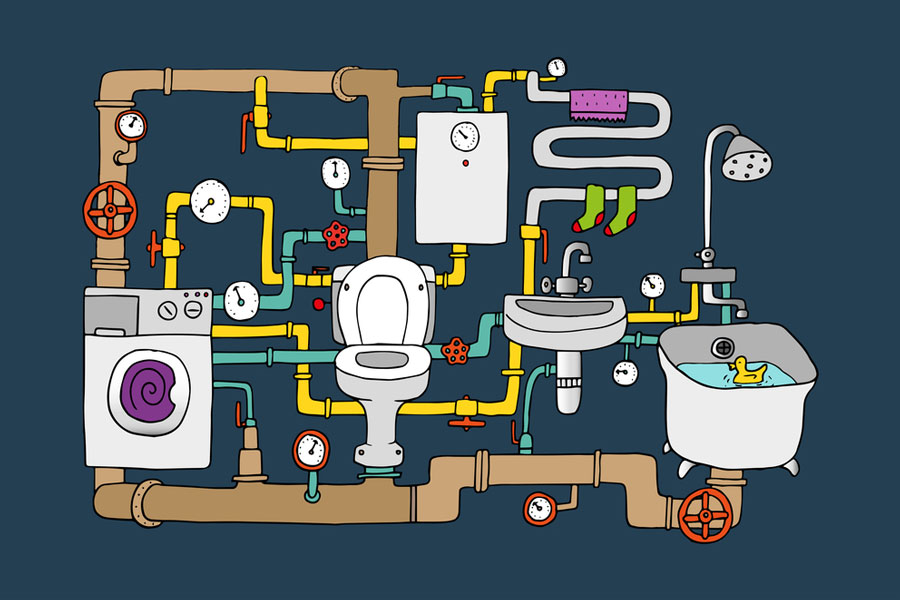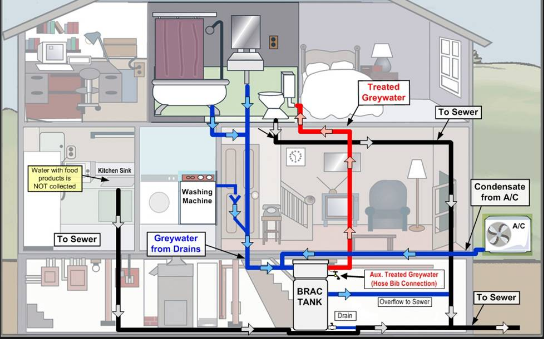How do you really feel about Understanding Your Home's Plumbing Anatomy?

Understanding just how your home's pipes system works is vital for every single home owner. From delivering clean water for drinking, food preparation, and bathing to safely eliminating wastewater, a well-kept pipes system is crucial for your family members's wellness and convenience. In this comprehensive guide, we'll explore the elaborate network that comprises your home's pipes and offer suggestions on maintenance, upgrades, and dealing with typical problems.
Intro
Your home's pipes system is greater than just a network of pipelines; it's a complex system that ensures you have accessibility to tidy water and reliable wastewater removal. Recognizing its elements and exactly how they interact can assist you avoid costly repair services and make certain everything runs smoothly.
Basic Elements of a Pipes System
Pipes and Tubes
At the heart of your pipes system are the pipelines and tubes that lug water throughout your home. These can be constructed from numerous products such as copper, PVC, or PEX, each with its benefits in regards to sturdiness and cost-effectiveness.
Components: Sinks, Toilets, Showers, and so on.
Components like sinks, bathrooms, showers, and tubs are where water is used in your home. Comprehending exactly how these fixtures connect to the plumbing system aids in detecting issues and preparing upgrades.
Valves and Shut-off Factors
Shutoffs regulate the circulation of water in your plumbing system. Shut-off shutoffs are critical throughout emergency situations or when you need to make repair work, allowing you to isolate parts of the system without disrupting water flow to the entire house.
Water Supply System
Key Water Line
The major water line links your home to the community water or a personal well. It's where water enters your home and is distributed to various components.
Water Meter and Stress Regulator
The water meter steps your water usage, while a pressure regulatory authority makes certain that water streams at a safe pressure throughout your home's pipes system, avoiding damages to pipes and components.
Cold Water vs. Warm water Lines
Understanding the difference between cold water lines, which provide water directly from the primary, and warm water lines, which bring heated water from the hot water heater, helps in repairing and planning for upgrades.
Water drainage System
Drain Piping and Traps
Drain pipes lug wastewater away from sinks, showers, and commodes to the drain or septic system. Traps prevent sewer gases from entering your home and additionally trap particles that might cause blockages.
Air flow Pipes
Air flow pipes permit air into the water drainage system, avoiding suction that can reduce drain and create traps to vacant. Proper air flow is important for preserving the honesty of your plumbing system.
Relevance of Proper Water Drainage
Guaranteeing correct drainage prevents backups and water damages. Frequently cleansing drains and preserving catches can protect against costly repair services and extend the life of your plumbing system.
Water Heater
Types of Water Heaters
Hot water heater can be tankless or conventional tank-style. Tankless heating systems heat water on demand, while containers save heated water for instant usage.
Upgrading Your Pipes System
Factors for Upgrading
Upgrading to water-efficient components or changing old pipelines can boost water top quality, decrease water expenses, and boost the worth of your home.
Modern Plumbing Technologies and Their Benefits
Check out technologies like smart leak detectors, water-saving commodes, and energy-efficient hot water heater that can conserve money and decrease environmental impact.
Cost Considerations and ROI
Calculate the upfront expenses versus long-lasting savings when thinking about pipes upgrades. Several upgrades spend for themselves through reduced utility expenses and fewer repair services.
Exactly How Water Heaters Link to the Pipes System
Comprehending exactly how water heaters link to both the cold water supply and warm water circulation lines aids in identifying problems like inadequate hot water or leaks.
Maintenance Tips for Water Heaters
On a regular basis purging your hot water heater to eliminate sediment, checking the temperature setups, and evaluating for leaks can extend its life-span and boost power effectiveness.
Typical Plumbing Issues
Leaks and Their Causes
Leakages can take place due to aging pipelines, loose fittings, or high water stress. Attending to leaks promptly prevents water damages and mold development.
Clogs and Obstructions
Blockages in drains and toilets are often brought on by purging non-flushable items or a buildup of oil and hair. Using drain displays and being mindful of what goes down your drains pipes can stop blockages.
Signs of Plumbing Problems to Expect
Low tide pressure, slow-moving drains, foul odors, or unusually high water costs are signs of possible plumbing troubles that must be dealt with promptly.
Pipes Maintenance Tips
Regular Examinations and Checks
Arrange annual pipes evaluations to capture problems early. Try to find signs of leakages, corrosion, or mineral build-up in faucets and showerheads.
Do It Yourself Maintenance Tasks
Straightforward jobs like cleaning tap aerators, looking for bathroom leakages using color tablets, or insulating subjected pipelines in chilly environments can avoid significant plumbing problems.
When to Call an Expert Plumber
Know when a pipes concern requires expert experience. Attempting complicated repair work without correct knowledge can cause even more damage and higher fixing expenses.
Tips for Lowering Water Usage
Basic behaviors like repairing leaks without delay, taking shorter showers, and running full lots of washing and dishes can save water and reduced your energy bills.
Eco-Friendly Plumbing Options
Consider sustainable plumbing products like bamboo for floor covering, which is durable and green, or recycled glass for countertops.
Emergency Readiness
Steps to Take During a Pipes Emergency situation
Know where your shut-off shutoffs are located and how to shut off the water system in case of a ruptured pipe or major leak.
Value of Having Emergency Situation Contacts Helpful
Keep call details for neighborhood plumbers or emergency services easily available for quick reaction during a plumbing dilemma.
Ecological Influence and Preservation
Water-Saving Components and Devices
Installing low-flow faucets, showerheads, and bathrooms can substantially minimize water use without compromising efficiency.
DIY Emergency Situation Fixes (When Relevant).
Temporary fixes like using air duct tape to spot a dripping pipeline or placing a pail under a trickling tap can lessen damages up until an expert plumbing gets here.
Verdict.
Comprehending the composition of your home's plumbing system empowers you to maintain it properly, conserving money and time on fixings. By adhering to routine maintenance routines and remaining informed about modern-day pipes modern technologies, you can ensure your plumbing system runs effectively for many years to come.
The Anatomy of Your Home s Plumbing System
Understanding the anatomy of your home s plumbing system is essential for any homeowner. It not only helps in identifying potential issues but also facilitates effective communication with professionals when repairs or upgrades are needed. Your home s plumbing system is more than just pipes and faucets; it s a complex network that ensures the efficient and hygienic flow of water in and out of your house. In this blog, we ll dissect the crucial components of your home s plumbing system. For those in Antelope Valley, Brock Plumbing is your trusted partner for all your plumbing needs, ensuring your system functions smoothly and efficiently.
Water Supply System
Main Water Line: This is where your home s plumbing system begins. The main water line connects your home to the public water supply or a private well. Pipes and Shut-off Valves: Pipes distribute water throughout your home. Shut-off valves are crucial for controlling the flow of water and making repairs without shutting off the entire system. Drainage System
Drain Pipes: These pipes carry waste and water away from sinks, toilets, and showers. Vents: Vents allow sewer gases to escape and help maintain proper pressure in the drainage pipes, ensuring efficient flow of wastewater. Traps: Every fixture has a trap, a U-shaped pipe that holds water and prevents sewer gases from entering your home. The most common is the P-trap under sinks. Fixtures and Appliances
Fixtures and appliances are the most interacted with parts of your plumbing system. They include sinks, toilets, showers, dishwashers, and washing machines. Each fixture and appliance has its own supply and drainage connection, ensuring they receive clean water and can dispose of wastewater effectively.
Water Heating System
Your water heater is a crucial component, providing hot water to various fixtures and appliances in your home. It can be tank-based or tankless, with each type having its own set of advantages and maintenance requirements. Regular maintenance is essential to ensure efficient operation and extend the lifespan of the unit.
Sump Pump
In areas prone to flooding or with high water tables, a sump pump is an essential part of the plumbing system. It s installed in the lowest part of your basement or crawlspace and pumps out water that accumulates, preventing flooding and protecting your home from water damage.
Septic System
Homes that are not connected to a municipal sewer system have a septic system and an underground wastewater treatment structure. Understanding how to maintain your septic system is crucial to prevent backups, odors, and early system failure.
Conclusion
Your home s plumbing system is a complex and essential network, ensuring the efficient and hygienic flow of water in and out of your property. Understanding its key components helps in maintaining it properly and identifying issues before they escalate into major problems. For residents in Antelope Valley, Brock Plumbing is dedicated to providing top-notch services, ensuring that every part of your plumbing system is in perfect working order. Trust our team of professionals to handle all your plumbing needs, ensuring your home remains comfortable, safe, and well-maintained.
https://brockplumbinganddrains.com/blog/the-anatomy-of-your-homes-plumbing-system/

I found that content on Anatomy of a House: Understanding the Components while doing a search on the internet. Are you aware of somebody who is curious about the topic? Take a moment to share it. Thank you so much for going through it.
Information